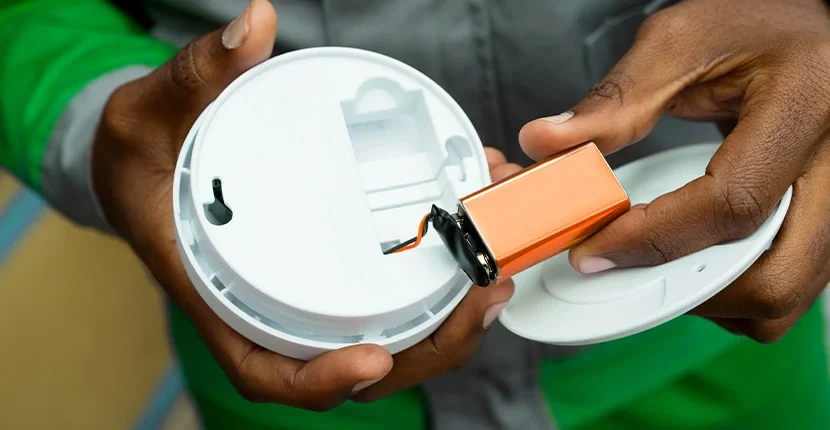Don't Wait for the Chirp: A Guide to Smoke & Carbon Monoxide Detector Safety
- by Joe Weber - updated on 10/10/2025

Key Takeaways
- Test Monthly, Change Yearly: Test your smoke and carbon monoxide detectors every month, and replace the batteries at least once a year.
- Know When to Replace: Smoke detectors should be replaced every 10 years, and carbon monoxide detectors every 7 years.
- Understand Your Detector Type: The three main types are battery-operated, 10-year sealed, and hardwired.
- Chirping Means Low Battery: If your detector is chirping, it's time to replace the battery (or the entire unit if it's a 10-year sealed model).
That intermittent, high-pitched chirp from your smoke detector is a sound that can test anyone's patience. But it's also a critical warning that your home's first line of defense against fire is running on a low battery. Being proactive about smoke and carbon monoxide detector maintenance is a simple step that can save lives. This guide will walk you through everything you need to know, from testing your detectors to knowing when it's time for a replacement.
Know Your Detector: Types of Smoke and CO Alarms
Before you can properly maintain your smoke alarms, you need to know what kind you have. There are three main types:
- Battery-Operated: These are the most common and run on disposable batteries, typically 9-volt, AA, or AAA.
- 10-Year Sealed Detectors: These units come with a built-in lithium battery designed to last for a decade. Once the battery dies, you replace the entire detector. Many states now require these sealed units.
- Hardwired Detectors: These are wired directly into your home's electrical system and have a backup battery for power outages.
Monthly Maintenance: Testing Your Detectors
Testing your smoke and carbon monoxide detectors should be a monthly habit. Here's how to do it:
- Smoke Detectors: Press and hold the "test" button. You should hear the alarm sound. If it's quiet or doesn't sound at all, replace the batteries. If it still doesn't work, the entire unit needs to be replaced.
- Carbon Monoxide Detectors: The process is similar to testing a smoke detector. Press the "test" button to check the battery and circuitry. For a complete safety check, you can also use a can of CO detector test spray to ensure the sensor is working correctly.
When to Replace Batteries and When to Replace the Unit
A chirping sound is the most obvious sign that it's time to replace your smoke alarm battery. But what if it's not chirping? It's recommended to replace the batteries in your smoke and carbon monoxide detectors at least once a year. A great way to remember is to change them when you change your clocks for Daylight Saving Time.
However, the detectors themselves don't last forever. Here's the recommended replacement schedule:
- Smoke Detectors: Every 10 years.
- Carbon Monoxide Detectors: Every 7 years.
You can find the manufacturing date on the back of the device to determine its age.
How to Replace a Smoke Alarm Battery
Replacing the batteries is a straightforward process:
- Safety First (for hardwired units): If you have a hardwired detector, turn off the power at the circuit breaker before you begin.
- Open the Cover: Most detectors have a twist-off cover or a small plastic lock you can open with a screwdriver.
- Swap the Batteries: Remove the old battery and insert the new one, making sure the positive and negative terminals are aligned correctly.
- Close and Test: Close the cover and press the "test" button to make sure everything is working.
Your Partner in Home Safety
Keeping your smoke and carbon monoxide detectors in perfect working order is one of the easiest and most important things you can do to protect your home and family. Whether you need a fresh set of long-lasting 9-volt batteries, a brand new 10-year sealed unit, or just some expert advice on what's right for your home, the team at your local Batteries Plus is here to help. Stop by today and let us provide you with the power and peace of mind you need to keep your home safe.
Frequently Asked Questions (FAQ)
Q: Why is my smoke detector chirping?
A: A chirping sound almost always means the battery is low. Replacing the battery should solve the problem.
Q: What kind of batteries do smoke detectors use?
A: Most smoke detectors use 9-volt batteries, but some models require AA or AAA batteries. Always check your specific device to ensure you're using the correct type.
Q: How often should I test my smoke detector?
A: You should test your smoke and carbon monoxide detectors at least once a month.
Q: Do I need an electrician to replace a hard-wired smoke detector?
A: While you can test and replace the backup batteries in a hardwired detector yourself, a qualified professional should always do the installation of a new hardwired unit.
Q: How long do smoke detectors last?
A: Smoke detectors should be replaced every 10 years, and carbon monoxide detectors should be replaced every 7 years.
Q: Do hardwired smoke detectors still have batteries?
A: Yes. Hardwired smoke detectors are connected to your home's electricity, but they also have a backup battery (usually a 9-volt) inside. This battery ensures the detector continues to work and protects your home during a power outage. It's just as important to replace this smoke alarm battery once a year to ensure it works during an outage.